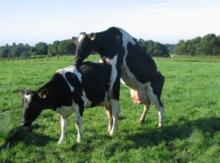Heat Detection
Getting cows in calf as quickly as possible is of great importance on a dairy farm. Conception rates are not easy to improve, but heat detection rate is. Good heat detection programmes can have a major impact on overall herd reproductive performance. While it seems obvious that cows not detected in heat will not get served and thus not get pregnant, accurate heat detection is important too, so that cows get inseminated at the right time.
Submission rates are a useful tool in assessing your current management of heat detection. Submission rates can be low (less than 70%) for 2 reasons:
1. Your cows are showing heat normally, but you are not detecting them
2. You have lots of 'non-cyclers' in your herd that are not showing heat normally, often caused by excessive body condition loss after calving, lameness or other health issues
Signs of cows in heat:
Interestingly in modern Holstein cows the duration of oestrus is reported to be only 7 hours, compared to 14 hours in Friesian cows in 1976. Coupled with the fact that they are most likely to show oestrus in the evening and that only half of the modern dairy cows show standing heat (see table below), you are quite likely to not see her at all!
Table 1 Behavioural signs of oestrus in cows*
Oestrus signs % of oestruses in which behaviour is displayed
Flehmen 44
Sniffing vulva of another cow 100
Mounted but not standing 56
Resting with chin on back of another cow 100
(Attempt to) mount another cow 90
(Attempt to) mount head side of another cow 22
Standing heat 56
*Adapted from Van Eerdenburg et al. (2002) and Roelofs et al. (2005b)
The Timing of AI still follows the am-pm rule: If cows are first seen in standing oestrus in the morning, they are served in the afternoon.
If cows are bulling in the afternoon, they are served in the morning.
Research indicates that this rule still applies, but timing of AI is less important than the accuracy of both heat detection and AI technique.
Maximising heat detection
- Observation periods of less than 30 minutes are unlikely to achieve targets for heat detection rates
- 90% of oestrus activity occurs outside feeding and milking time
- As 25% of cows will bull less than 6 hours, a minimum of 3 observations a day is needed
- Use action lists: Which cows are due for service?
- Accurate recording and communication
- Good clear cow identification
- Involve all staff in oestrus detection to maximise resources
- Use oestrus detection aids
- Use intervention points: voluntary waiting period, presentation of 'non-bullers' and pregnancy diagnosis to vet
Standing heat used to be the gold standard in heat detection, but is essential to supplement oestrus observation with the use of heat detection aids like:
- Tail paint - very cheap, needs topping up frequently
- Heat mount detectors - cheap, need to check at least daily
- Activity Meters - proven technology, set threshold carefully
- Keeping bulls - health and safety issues, venereal disease risk
- Milk progesterone monitoring - systematic approach and repeat sampling needed
High yielding dairy cows, increasing herd size and fewer skilled personnel can make oestrus detection challenging. However, good levels of oestrus detection can be achieved by investing in staff skills, detection time and detection aids.
Please give us a call to discuss any of the above on 01363 772860, or email us here.


